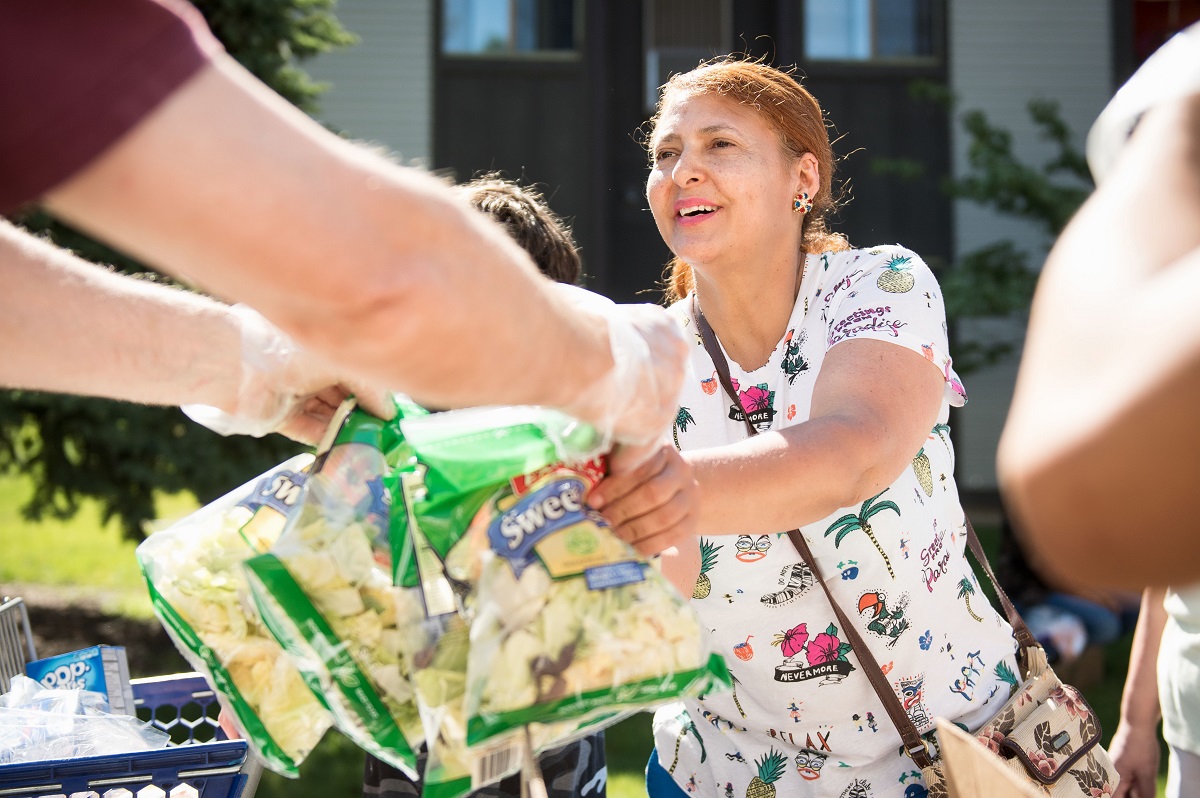WRITER | MEGAN WESTERS
PHOTO | FEEDING AMERICA WEST MICHIGAN, UNIVERSITY OF MICHIGAN
We’ve all done it. The meal where you struggled to finish and left food on your plate, not thinking twice about throwing it away. What if you took each bite of unfinished food over the course of your life and calculated out how much waste that would equal?
According to the USDA’s Economic Research Service, approximately 30 to 40 percent of all food produced and consumed in the United States goes to waste. At the same time, 41 million Americans struggle with hunger each year, a number that corresponds almost exactly to the 40 million Americans living in poverty, according to the Feeding America nonprofit organization. The repercussions of this problem go much further than the juxtaposition between food waste and hunger. Every year, wasted food makes up the majority of all components dumped into municipal landfills – far more than glass, plastic, or metal. Even worse, food waste generates methane, making landfills the third-largest source of greenhouse gas in the United States, according to the USDA.
Luckily, people are doing something about it.
A food delivery box service called Imperfect Produce based in San Francisco is taking the problem into its own hands. Like other food delivery programs, there are planned food options to choose from on a subscription basis. But unlike other such services, Imperfect Produce doesn’t deliver ingredients to cook full meals with recipes; it delivers fruits and vegetables that, for cosmetic reasons, don’t meet grocery store requirements and are typically thrown out as waste.
“Ugly” fruits and vegetables are delivered to customers’ doors either weekly or biweekly for 30 to 50 percent less than what “perfect” produce would cost at grocery stores. Since opening in 2015, Imperfect Produce has saved 14.5 million pounds of food and 772 million gallons of water from becoming waste. While saving its customers $6.5 million in grocery bills, it has saved the environment 42.3 million pounds of carbon dioxide by preventing that food from ending up in landfills. Although Imperfect Produce doesn’t deliver to Michigan (yet), its impact on those facing hunger and malnutrition, the environment, and America’s food waste shows just how far-reaching the problem is.
Organizations and individuals in Michigan are taking notice as well, and rather than approaching the problem on a national level like Imperfect Produce; these people are tackling the problem at the local level.
Kenneth Estelle, president and CEO of Feeding America West Michigan, said that his organization has developed several food rescue programs by partnering with local farmers and companies that cannot sell their product.
In many cases, produce being rejected, wasted, and destroyed is merely the result of cosmetic defects such as oddly shaped produce or brown spots. “As a large regional food bank, we are committed to rescuing good food from manufacturers, processors, retailers, farmers, and other food brokers to keep it from going in the landfill,” said Estelle.
Similar to the Imperfect Produce business model, Feeding America West Michigan (FAWM) rescues food from a number of organizations. Regardless of origin, FAWM transports the produce to its warehouse where it is inspected, packaged, labeled, and made available to food pantries, meal programs, and group homes within the 40 counties that FAWM serves. Partnering agencies either pick up the food at the warehouse or it is delivered via FAWM’s trucks.
“We reach approximately 492,000 people in our 40-county service area who are food insecure,” said Estelle. “That is one in eight people, and one in six children.”
In Southeast Michigan, the University of Michigan is taking this problem just as seriously but tackling it from a different perspective.
Keith Soster, director of student engagement at the University of Michigan’s Dining Services, is leading the many initiatives that the school has implemented.
“We did away with trays about five years ago,” said Soster. Previously, he explained, students had a set number of dining hall trips on their meal plans. Wanting to make each trip count, they would load up their trays with food they couldn’t finish. Under the new plan, students now take what they want and make additional trips if they are still hungry. The college has also switched to smaller, tapas-style options as well, ensuring the least amount of waste possible.
“It creates more options for the students, and it promotes healthier eating patterns as well. You’ll eat when you’re hungry rather than when you’re forced to,” he said.
Other food-related initiatives at the university include composting; collaboration by a student-led group with Food Gatherers, a local food bank; and a switch in disposable goods from plastic to paper or wood.
“I think it’s cool. Our youth, students coming into college now, are focused on [these environmental issues], not just because they are an environmental major. Students are the push behind this; our future leaders want to change the way we are doing things now, and we have to embrace their initiatives,” said Soster.
“Back in 2011, our then president, Mary Coleman, wanted to make an impact sustainability-wise. She got integrative assessment teams of students and staff together to represent five broad goals, and one of them was concerned with food waste,” explained Soster.
The University of Michigan’s overall goal is to buy 20 percent local and sustainable food by the year 2025 and to reduce landfill waste by 40 percent by the year 2025 as well.
Currently, the campus as a whole (including nine dining halls, nearly 30 retail shops, three catering facilities, the hospital, and athletics), is buying 15 percent sustainable and local. As of February of 2018, the dining unit alone was diverting food waste to compost by 29 percent.
Soster said that the university brings in 7,000 new students each year. If this is at the forefront of each student’s experience, it won’t take long to see a major change regarding the food waste problem here in the mitten state. “Our focus is getting our students to develop habits that last a lifetime.”
Currently, there are a limited number of organizations in Michigan actively involved in food rescue. As topic visibility increases, so, too, will the organizations committed to reducing food waste. Visit SustainableAmerica.org to see how you can get involved.








